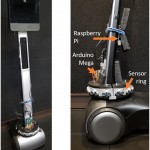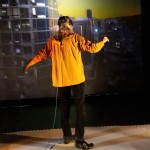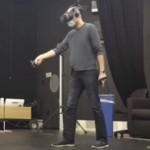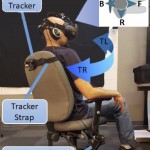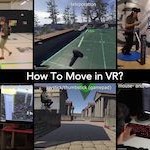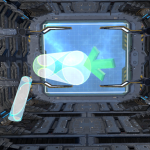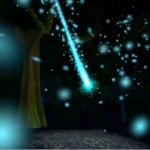
Biography
Ivan joined the iSpace team in Fall 2017 as a PhD student.
He has a Bachelor in Computer Science and Master’s in Media and Technology, both from the Sao Paulo State University (UNESP) in Brazil, where he researched in the areas of Augmented Reality, Pre-visualization for the Film Pipeline, Photogrammetry, and Computer Graphics. His current research focuses on using interdisciplinary approaches to investigate, develop, and test human-computer interfaces for virtual and augmented reality.
Projects
Telepresence
How can we improve telepresence systems (such as conference robots) so they are not just "zoom on wheels" but actually allow users to feel more present and navigate more easily around remote environments?" FeetBack: Augmenting Robotic Telepresence with Haptic Feedback on the Feet Telepresence robots allow people to participate in remote spaces, yet they can be difficult to manoeuvre with people ...
HyperJump flying to combat motion sickness
HyperJumping in Virtual Vancouver: Combating Motion Sickness by Merging Teleporting and Continuous VR Locomotion in an Embodied Hands-Free VR Flying Paradigm Motion sickness, unintuitive navigation, and limited agency are critical issues in VR/XR impeding wide-spread adoption and enjoyable user experiences. To tackle these challenges, we present HyperJump, a novel VR interface merging advantages ...
Concurrent locomotion and interaction in VR
Can more embodied and leaning-based interfaces help support concurrent locomotion and interaction in VR when physical walking isn't feasible? Physical walking is often considered the gold standard for VR travel whenever feasible. However, especially for larger-scale virtual travel the free-space walking areas are typically too small, thus requiring handheld controllers to navigate, which ...
Leaning-based interfaces improve ground-based VR locomotion
Hand-held VR controllers are widely available and used, however they can contribute to unwanted side-effects, such as increased cybersickness, disorientation, and cognitive load. Here, we show how a leaning-based interfaces ("HeadJoystick") can help improve user experience, usability,and performance in diverse ground-based navigation including three complementary tasks: reach-the-target, follow-th...
VR Locomotion Interfaces Survey: How to Move in VR?
There are a multitude of different VR locomotion interfaces out there, all with their own pros and cons. In fact, far too many to all investigate in one behavioural study - so let's ask diverse VR experts for their opinion... Interested in supporting research on VR locomotion interfaces and helping the VR community better understand the pros and cons of different interfaces? We created a surve...
Embodied & Intuitive Flying for VR, Gaming, and TeleOperation
Flying has been a dream for mankind for millenia - but flying interfaces for VR, gaming, and teleoperation (e.g., drones) typically rely on cumbersome double-joystick/gamepads and do not allow for intuitive and embodied flying experiences. Here, we develop low-cost embodied flying interfaces that adapt leaning-based motion cueing paradigms thus freeing up hands for additional tasks beyond just na...
Connected through "AWE": creating immersive experiences for social connection
Do you get enough “awe” in your life? In our busy day-to-day lives, we often take our experiences for granted. While we have the technology to connect with one another, like smart phones, we don’t necessarily get outside with nature, or stargaze. Such activities may consist of common awe-inspiring moments, and we now understand that feeling awe is associated with all sorts of social and well...
Virtual Earthgazing - towards an overview effect in Virtual Reality
How can we use immersive VR to give people pivotal positive experiences without having to send them out into space? “We went to the Moon as technicians, we returned as humanitarians” reflected Edgar Mitchell after his space flight. This describes the overview effect – a profound awe-inspiring experience of seeing Earth from space resulting in a cognitive shift in worldview, le...
